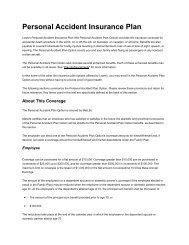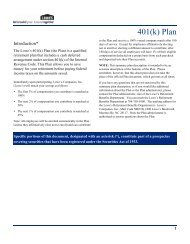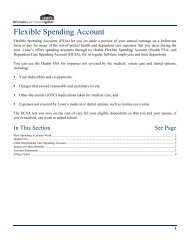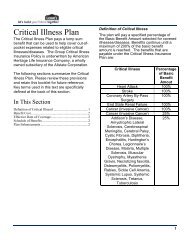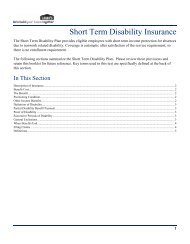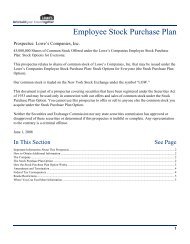Personal Accident Insurance - My Lowe's Life
Personal Accident Insurance - My Lowe's Life
Personal Accident Insurance - My Lowe's Life
You also want an ePaper? Increase the reach of your titles
YUMPU automatically turns print PDFs into web optimized ePapers that Google loves.
<strong>Personal</strong> <strong>Accident</strong> <strong>Insurance</strong> PlanLowe’s <strong>Personal</strong> <strong>Accident</strong> <strong>Insurance</strong> Plan (the <strong>Personal</strong> <strong>Accident</strong> Plan Option) provides life insurancecoverage for accidental death anywhere in the world, on or off the job, on business, on vacation, or athome. Benefits are also payable to covered individuals for bodily injuries resulting in dismemberment, lossof use or loss of sight, speech, or hearing. The <strong>Personal</strong> <strong>Accident</strong> Plan Option covers you and your familywhile flying as passengers in any licensed civilian aircraft.The <strong>Personal</strong> <strong>Accident</strong> Plan Option also includes several enhanced benefits. Each of these enhancedbenefits may not be available in all areas. See “Plan Enhancements” on page 5 for more information.Unlike some of the other life insurance plan options offered by Lowe’s, you may enroll in the <strong>Personal</strong><strong>Accident</strong> Plan Option at any time without having to provide proof of good health.The following sections summarize the <strong>Personal</strong> <strong>Accident</strong> Plan Option. Please review these provisions andretain this booklet for future reference. Key terms used in this text are specifically defined at the back ofthis section.In This SectionSee PageAbout This Coverage ............................................................................................................................................................................... 2Benefit Cost ............................................................................................................................................................................................. 3Late Enrollment ....................................................................................................................................................................................... 3Outline of Benefits................................................................................................................................................................................... 3Plan Enhancements .................................................................................................................................................................................. 5Exclusions ............................................................................................................................................................................................... 7Beneficiaries ............................................................................................................................................................................................ 8Filing Claims ........................................................................................................................................................................................... 8Definitions ............................................................................................................................................................................................... 81
About This CoverageThe <strong>Personal</strong> <strong>Accident</strong> Plan Option is insured by Met<strong>Life</strong>.Met<strong>Life</strong> certifies that an employee who has satisfied or satisfiesin the future the eligibility and enrollment provisions of the<strong>Personal</strong> <strong>Accident</strong> Plan Option will be eligible for the <strong>Personal</strong><strong>Accident</strong> Plan Option benefits, as described in this section.The employee can elect one of the <strong>Personal</strong> <strong>Accident</strong> PlanOption’s coverage amounts for himself/herself and, if desired,can elect a coverage amount for himself/herself and his/herdependents under the Family Plan.EmployeeCoverage can be purchased for a flat amount of $10,000.Coverage greater than $10,000 can be purchased in incrementsof $25,000 up to $300,000, and for coverage greater than$300,000 in increments of $100,000. The maximum limit oncoverage is the lesser of $1,000,000 or the flat amount notexceeding 10 times Base Annual Earnings.The amount of the employee’s or a dependent spouse’s ordomestic partner’s coverage (if the employee elected to enrollin the Family Plan) may be reduced when the employee or thedependent spouse or domestic partner reaches age 70. At theemployee’s or the dependent’s attained age of 70, the principalsum benefit shall be the lesser of:• The amount of the principal sum benefit provided prior toage 70; or• $100,000.The reductions take place at the end of the calendar year inwhich the employee or the dependent spouse or domesticpartner attains age 70.The premium rate shall remain the same, but the employee’scost will be reduced so that the employee only pays premiumsbased on his/her new age-reduced coverage amount. Theemployee may not increase coverage after age 70.must purchase if you choose to enroll in the <strong>Personal</strong> <strong>Accident</strong>Plan Option is $10,000.Benefits under the Family Plan are calculated as a percentageof the benefit amount you select for yourself, and based on thecomposition of your family at the time of loss. The percentagesare as follows:• If, at the time of loss, your family consists of you and yourspouse or domestic partner, but NO children, then thebenefit under the Family Plan will be:Employee100% 100%Spouse or DomesticPartner• If, at the time of loss, your family consists of you, yourspouse or domestic partner and dependent children and/ordomestic partner’s children, then the benefit under theFamily Plan will be:EmployeeSpouse orDomesticPartner100% 80% 15%Each Childand/orDomesticPartner’s Child• If, at the time of loss, your family consists of you and yourdependent children and/or domestic partner’s children butNO spouse or domestic partner, then the benefit under theFamily Plan will be:Employee100% 25%Each Child and/or DomesticPartner’s ChildDependentsUnder the Family Plan, you can purchase up to $500,000 incoverage for your spouse or domestic partner and up to$100,000 for each eligible dependent child or domesticpartner’s child. The minimum amount of coverage that you2
Exposure and DisappearanceBenefits will be provided if an injury is sustained by a coveredindividual who is unavoidably exposed to the elements andsuffers a loss as a result, or if the individual is assumed to havesuffered a loss of life due to the individual’s disappearance, asdescribed below.Under the <strong>Personal</strong> <strong>Accident</strong> Plan Option, a covered individualis assumed to have suffered loss of life if:• The individual is riding in a common carrier that isinvolved in an accident covered under this policy;• As a result of the accident, the common carrier is wrecked,sinks or disappears; and• The insured’s body is not found within one year of theaccident.Common DisasterA benefit is payable if a covered employee and his/her coveredspouse or domestic partner die as a result of injuries sustainedin the same accident. Benefits will be paid in accordance withthe beneficiary designation provision or to the designatedguardian for the covered employee’s dependent children and/orthe domestic partner’s children. Both the death of the coveredemployee and of the covered spouse or domestic partner mustoccur within 365 days of the accident that caused the injuriesresulting in death. The benefit will increase the coveredspouse’s or domestic partner’s benefit to equal the amount ofthe covered employee’s benefit under the <strong>Personal</strong> <strong>Accident</strong>Plan Option.Benefits Schedule for Covered EmployeesLoss<strong>Life</strong>Both hands or both feet orsight of both eyesOne hand and one footOne hand or foot and sight ofone eyeSpeech and hearingOne hand or one FootBenefit AmountsPrincipal sumPrincipal sumPrincipal sumPrincipal sumPrincipal sum50% of principal sumLossSpeech or hearingSight of one eyeThumb and index finger of thesame handHearing in one earUse of four limbsUse of three limbsUse of two limbsUse of one limbBenefit Amounts50% of principal sum50% of principal sum25% of principal sum25% of principal sumPrincipal sumPrincipal sumPrincipal sum50% of principal sumIf you select the Family Plan, then the benefit amountsapplicable to your family members who incur the loss of life ormember are outlined in the table below.Benefit Schedule for Covered DependentsCovered Dependent Benefit AmountsSpouse or DomesticPartner only coveredSpouse or DomesticPartner and childrencovered:Spouse or DomesticPartnerEach child and/orDomestic Partner’s ChildChildren and/or DomesticPartner’s Children onlycovered:Each child and/orDomestic Partner’s Child100% of the employee’s benefit*80% of the employee’s benefit***15% of the employee’sbenefit***25% of the employee’sbenefit** See “Benefits Schedule for Covered Employees” table above.**Payable for death of dependent child or domestic partner’s child only. Benefitpayable for dismemberment and loss of use for dependent children or domesticpartner’s children is equal to two times the benefit shown in the “BenefitsSchedule for Covered Dependents” table.4
Coma BenefitBenefits will be provided to the employee and covereddependents if the employee or dependent sustains an injurythat, independent of all other causes, directly results in theindividual being in a coma within 30 days of injury. The benefitwill be paid at a rate of:• 2% per month for a maximum of 100 months foremployees; or• 1% per month for a maximum of 100 months for covereddependents.A waiting period of 31 days from the date that the insuredindividual becomes comatose will be applied before anypayment of coma benefits takes place.Brain Damage BenefitBenefits will be provided if a covered individual sustains aninjury that, independent of all other causes, directly results in atraumatic brain injury causing brain damage. The benefit willbe equal to 100% of the covered individual’s coverage underthe <strong>Personal</strong> <strong>Accident</strong> Plan Option, if all of the followingconditions are met:• The brain damage begins within 60 days of the injury,• Require hospitalization for at least 5 days, and• The brain damage continues for 12 consecutive monthsPayment of this benefit plus any other benefit payable as aresult of the same accident will not exceed the <strong>Personal</strong><strong>Accident</strong> Plan Option benefit that the covered individual iseligible to receive.<strong>Personal</strong> <strong>Accident</strong> <strong>Insurance</strong> PlanPlan EnhancementsHospital Confinement Monthly IncomeBenefitIf a covered person is confined in a hospital for more than threeconsecutive days, the covered person will receive two percentof his or her coverage under the <strong>Personal</strong> <strong>Accident</strong> Plan Optionfor each full month ( 1 ⁄ 30 of the monthly benefit for each day ofa partial month) of hospitalization, provided the followingrequirements are met:• The hospitalization is the result of an accident, directly andwith no other causes, while coverage is in force;• The covered person is under a Doctor’s care; and• The hospital stay begins while the person is covered.Payments will begin after the three-consecutive-day minimumconfinement period. The benefit payments cannot exceed 12months in duration, and the monthly benefit cannot exceed$5,000.Education BenefitIf a covered employee who elected the Family Plan dies as aresult of an injury within one year after the date of the accidentcausing the injury, an education benefit is payable to each ofthe covered employee’s qualified children. For purposes of theeducation benefit, a qualified child is any of the coveredemployee’s unmarried dependent children under age 25 who,on the date of the covered employee’s covered death, is either:• Enrolled as a full-time student in an accredited postsecondaryinstitution of higher learning beyond the 12 thgrade level; orth• At the 12 grade level and enrolls as a full-time student inan accredited post-secondary institution of higher learningwithin 365 days following the date of the coveredemployee’s death.Met<strong>Life</strong> must receive proof that the child is a qualified child,and the qualified child must continue to be enrolled as afull-time student in an accredited post-secondary institution ofhigher learning for full-time students beyond the 12th gradelevel.5
The education benefit is payable semi-annually for each childwho qualifies when Met<strong>Life</strong> receives proof that tuition chargeshave been paid:• In an overall maximum amount equal to 10% of theprincipal sum;• Per academic year, but not more than four consecutiveacademic years; and• In an amount not to exceed $25,000 per academic year.Education benefits end for each qualified child on the earliestof:• The date the qualified child fails to furnish proof requiredor• The total maximum benefit payable under the child-carebenefit is paid by Met<strong>Life</strong>;If, at the time of accident, coverage is in force, but there is nodependent child who qualifies for an education benefit, anadditional benefit of $1,000 will be paid to the designatedbeneficiary.Child-Care BenefitIf a covered employee who elected the Family Plan dies as aresult of an injury within one year of the accident causing theinjury, a child-care benefit is payable to the coveredemployee’s authorized representative for the benefit ofqualified children.For purposes of the child-care benefit, a qualified child is anyof the covered employee’s dependent children under age 12 andenrolled in a licensed day-care facility, school facility, oranother similar program or enrolls in such a program within 12months following the date of the covered employee’s death..Child-care expenses will be reimbursed for each qualified childup to a maximum of $7,500 per year for four consecutive years,not to exceed 12% of the child maximum benefit payable.If, at the time of death, the covered employee has no dependentchildren eligible for the child-care benefit, $2,000 will be paidto the covered employee’s designated beneficiary.Spouse or Domestic Partner TrainingBenefitA spouse or domestic partner training benefit may be payable ifa covered employee dies as a result of an injury. Proof that thecovered employee’s death is a result of an injury must beprovided. The benefit covers the actual cost incurred for aperiod of 5 years by the covered employee’s dependent spouseor domestic partner for an accredited school commencingwithin 24 months from the date of the death. The totalmaximum amount payable is 10% of the employee’s coverageamount, but no more than $5,000 per academic year.The dependent spouse or domestic partner is eligible to receivea spouse or domestic partner training benefit if he/she iscovered under the policy on the date of the covered employee’saccident.If this benefit is in effect on the date You die and there is noSpouse or Domestic Partner who could qualify for it, Met<strong>Life</strong>will pay $1,000 to your designated beneficiary in one lumpsum.Seat Belt and Air Bag BenefitIf a covered individual suffers loss of life as a result of anautomobile accident, the covered individual’s beneficiary mayreceive a seat belt benefit of 15% of the covered individual’sbenefit under the <strong>Personal</strong> <strong>Accident</strong> Plan Option. Themaximum seat belt benefit payable is $25,000. A seat beltbenefit is payable only if:• The covered person was operating or riding in a privatepassenger car;• The private passenger car is equipped with seat belt(s) thatmeet published United States Government safetystandards, are properly installed by the car manufacturer,and not altered after installation;• The seat belt(s) were in actual use and properly fastened*at the time of the covered accident; and• The position of the seat belt(s) are certified in the officialreport of the covered accident, or by the investigatingofficer.A copy of the police accident report must be submitted with theclaim. If the report indicates that the covered individual was notwearing a seat belt or was not wearing a seat belt correctly, noseat belt benefit will be paid. In addition, no benefit will bepaid if the covered individual is the driver of the privatepassenger car and does not hold a current and valid driver’slicense, or if the covered individual was under the influence ofalcohol or drugs.* An automatic harness seat belt is not considered fastened unless a lap belt is alsoused.6
An additional air bag benefit of $5,000 will be paid if:<strong>Personal</strong> <strong>Accident</strong> <strong>Insurance</strong> PlanAny drug, medication or sedative, unless it is:• The private passenger car is equipped with a single air bagand the covered individual is the driver;• The private passenger car is equipped with an air bag forboth the driver and the front passenger seat, and thecovered individual is the driver or in the front passengerseat; or• The private passenger car is equipped with an air bag forthe driver seat, the front passenger seat, and air bags forpassenger seats; and the covered individual is the driver,the front seat passenger, or a rear seat passenger; and• The seat belt(s) are in actual use and properly fastened atthe time of the covered accident.Medical Continuation BenefitIf the employee elects coverage under the Family Plan foremployee and spouse or domestic partner, employee andchildren, or employee and family, and the covered employeedies as the result of an injury, an amount equal to the groupmedical insurance premiums will be paid under the <strong>Personal</strong><strong>Accident</strong> Plan Option to the covered employee’s beneficiaries.Proof must be provided regarding the cause of the coveredemployee’s death, and that the covered spouse or domesticpartner and/or children have continued medical coverage aspermitted under the Consolidated Omnibus BudgetReconciliation Act (COBRA) of 1985.• Taken or used as prescribed by a Physician, or• An “over the counter” drug, medication orsedative taken as directed;Alcohol in combination with any drug, medication, orsedative; orPoison, gas, or fumes;• Service or full-time active duty in the armed forces of anycountry or international authority except the United StatesNational Guard;• Physical or mental illness or infirmity, or diagnosis ortreatment of such illness or infirmity;• Infection, other than infection occurring in an externalaccidental wound;• Any incident related to:Travel in an aircraft as a pilot, crew member, flightstudent or while acting in any capacity other than as apassenger;Travel in an aircraft for the purpose of parachuting orotherwise exiting from such aircraft while it is inflight;Parachuting or otherwise exiting from an aircraft whilesuch aircraft is in flight, except for self-preservation;The maximum benefit payable under the medical continuationbenefit is $5,000 per year up to a maximum benefit period ofthree years, with an overall maximum payable of 5% of the fullamount available under the Benefits Schedule.Travel in an aircraft or device used:• For testing or experimental purposes;• By or for any military authority; orExclusionsNo benefits will be paid for loss resulting from:• Intentionally self-inflicted injuries, suicide, or any suicidalattempt while sane or insane (in Missouri, only whilesane);• War, whether declared or undeclared; or act of war,insurrection, rebellion or riot;• The voluntary intake or use by any means of:• For travel or designated for travel beyond theearth’s atmosphere;• An attempt to commit or commission of a felony understate or federal law; or• The voluntary ingestion of that percentage of alcohol in thecovered individual’s blood that raises a presumption thatthe covered individual was driving any vehicle used fortransportation while under the influence of alcohol. Theblood alcohol level that raises this presumption is governedby the laws of the state in which the accident occurred.7
BeneficiariesLoss of life benefits will be paid to the beneficiary named onthe personal accident (Group <strong>Life</strong> <strong>Insurance</strong> / “VoluntaryAD&D”) portion of the Met<strong>Life</strong> <strong>My</strong>Benefits web site,accessible via the employee portal at www.myloweslife.com(<strong>My</strong> Lowe’s <strong>Life</strong> > <strong>My</strong> Health > Health Related Quick Links >Met <strong>Life</strong> <strong>Life</strong> <strong>Insurance</strong>) . An employee naming his/her spouseor domestic partner as beneficiary should show her name asMary Jones Smith, not Mrs. John Smith, or his name as JohnJones Smith, not Mr. John Smith.You will be the beneficiary for your spouse’s or domesticpartner’s and dependent children’s or domestic partner’schildren’s loss of life benefits unless you designate otherwise.You may change your beneficiary at any time. You may nameanyone as your beneficiary by listing his/her name (or names, ifyou elect multiple beneficiaries) on the personal accident(Group <strong>Life</strong> <strong>Insurance</strong> / “Voluntary AD&D”) portion of theMet<strong>Life</strong> <strong>My</strong>Benefits web site accessible via the employeeportal at www.myloweslife.com (<strong>My</strong> Lowe’s <strong>Life</strong> > <strong>My</strong> Health> Health Related Quick Links > Met <strong>Life</strong> <strong>Life</strong> <strong>Insurance</strong>). Theeffective date of the change is the date you submit your changerequest on the Met <strong>Life</strong> <strong>My</strong>Benefits web site. However, neitherLowe’s nor Met<strong>Life</strong> is liable for any amount paid before therequest is submitted online.The beneficiary’s consent to the change is NOT required.Filing ClaimsWritten notice of a claim must be given within 180 days after acovered loss begins, or as soon as reasonably possible. Forwardthe completed claim form to Met<strong>Life</strong>. Met<strong>Life</strong> will certifycoverage under the <strong>Personal</strong> <strong>Accident</strong> Plan Option. When theclaim has been processed, you or your beneficiary will benotified of the benefits paid.If there is no surviving beneficiary, your loss of life benefitswill be paid to the first surviving class of the following classesof beneficiaries:• Spouse or domestic partner of the covered person;• Children, and/or domestic partner’s children, equally, ifliving; otherwise to their descendents based on the terms ofthe policy;• Parents, equally, or to the survivor; or• Brothers or sisters, equally, or to the survivor or survivors.If there are no surviving members of the above, benefits will bepaid to your estate. All other benefits will be paid to you.Met<strong>Life</strong> will pay the cost and have the right to have the coveredperson examined as often as reasonably necessary while a claimis pending. Met<strong>Life</strong> may have an autopsy made, at its expense,unless prohibited by law.No legal action to get policy benefits may be brought less than60 days nor more than three years (Kansas, five years; SouthCarolina, six years) after written proof of loss has beenfurnished as required by the policy.The policy is not in lieu of and does not affect any requirementfor coverage under any workers’ compensation insurance.DefinitionsBase Annual Earnings: For hourly and salaried employees,the gross annual income in effect just prior to the date of loss. Itincludes your total income before taxes. It is prior to anydeductions made for pretax contributions to a qualified deferredcompensation plan, Section 125 plan, or Flexible SpendingAccount. It does not include income received fromcommissions, bonuses, overtime pay, incentive compensation(such as stock options or grants), any other extra compensation,or income received from sources other than Lowe’s.Doctor:• A person performing tasks that are within the limits ofhis/her medical license; and• A person who is licensed to practice medicine, to prescribeand administer drugs or to perform surgery; or a personwith a doctoral degree in psychology (Ph.D. or Psy.D.)whose primary practice is treating patients; or• A person who is a legally qualified medical practitioner,according to the laws and regulations of the governingjurisdiction.Met<strong>Life</strong> will not recognize the insured, or the insured’s spouseor domestic partner, children and/or domestic partner’schildren, parents, or siblings as a Doctor for a claim that theinsured sends to Met<strong>Life</strong>.Hospital: A legally created institution that:• Is mainly for the care and treatment of sick, ailing orinjured inpatients;• Is run by a staff of one or more Doctors available at alltimes;8
<strong>Personal</strong> <strong>Accident</strong> <strong>Insurance</strong> Plan• Provides nursing service at all times;• Provides organized diagnostic and surgical facilities; and• Is not primarily a clinic or facility for convalescence, rest,nursing, custody, extended care, or a facility for theelderly, drug addicts, or alcoholics.Loss of foot: All of the foot is severed at or above the anklejoint.Loss of hand: All of the hand is severed at or above the wrist.Loss of hearing: The total and irrevocable loss of hearing inboth ears that continues for 12 consecutive months followingaccidental injury.Loss of sight: Permanent and uncorrectable loss of sight in theeye. Visual acuity must be 20/200 or worse in the eye or thefield of vision must be less than 20 degrees.Loss of speech: The total and irrevocable loss of speech thatcontinues for 12 consecutive months following accidentalinjury.Loss of thumb or index finger: The whole thumb and indexfinger are cut off at or above the joint closest to the wrist.Loss of use: The total paralysis of a limb or limbs that isdetermined by competent medical authority to be permanent,complete, and irreversible.9



